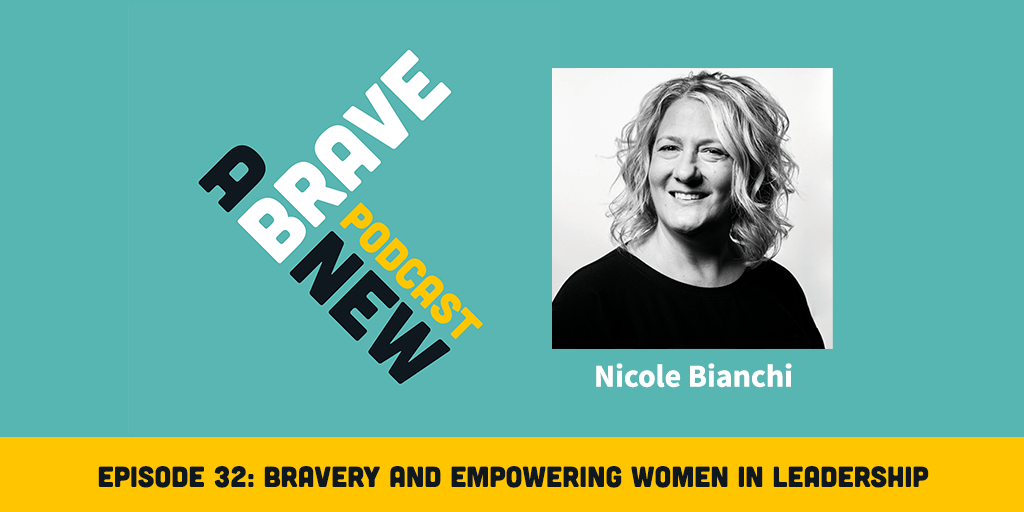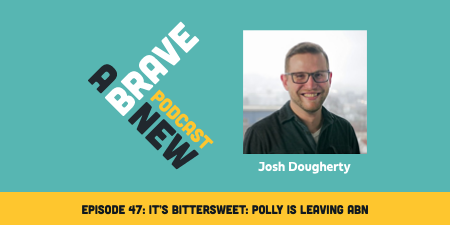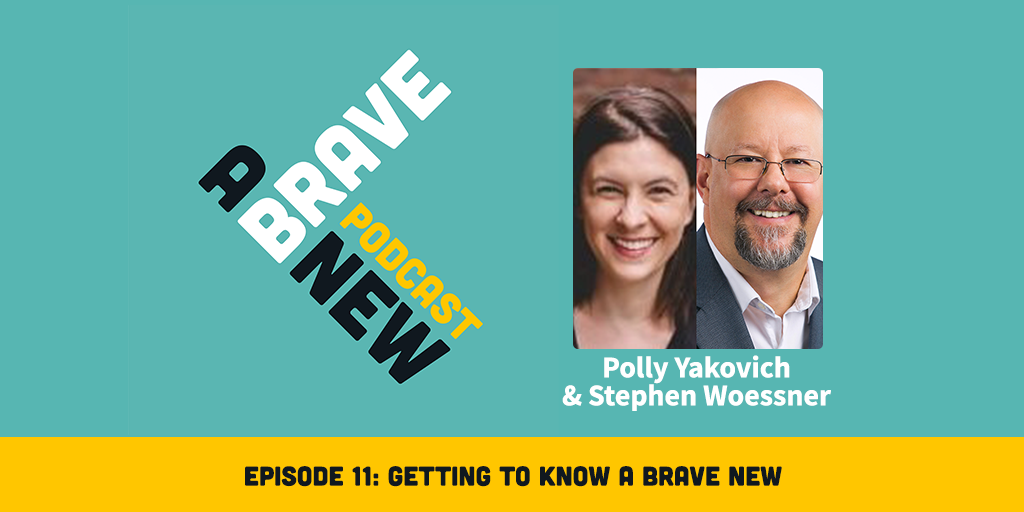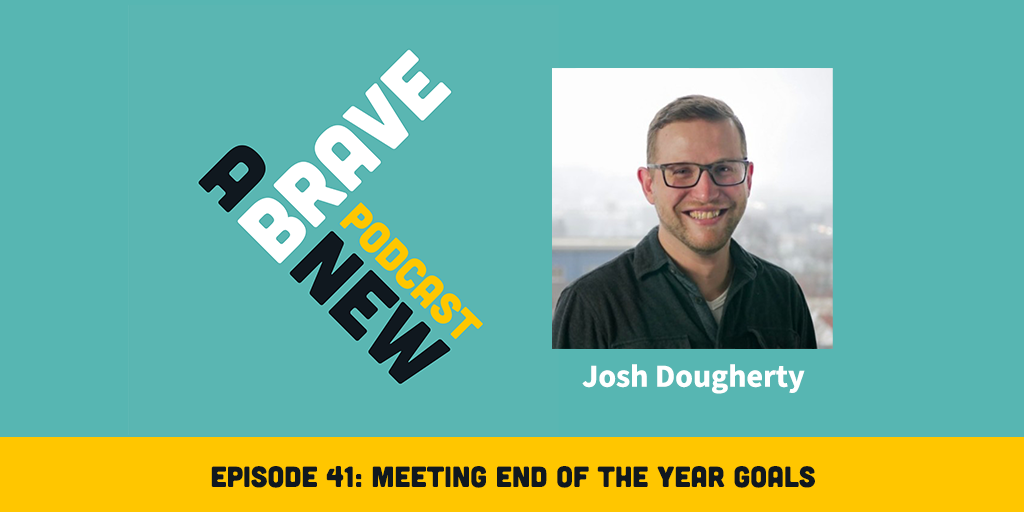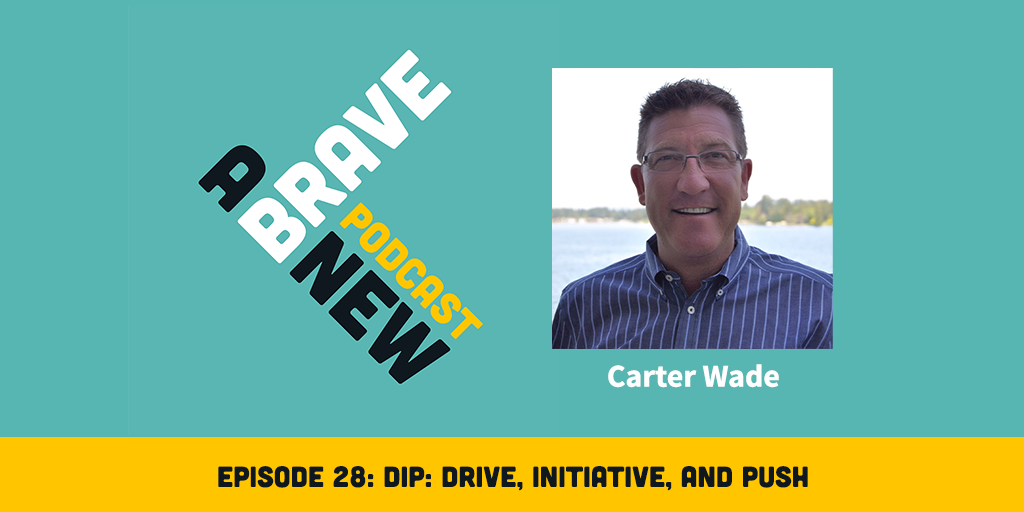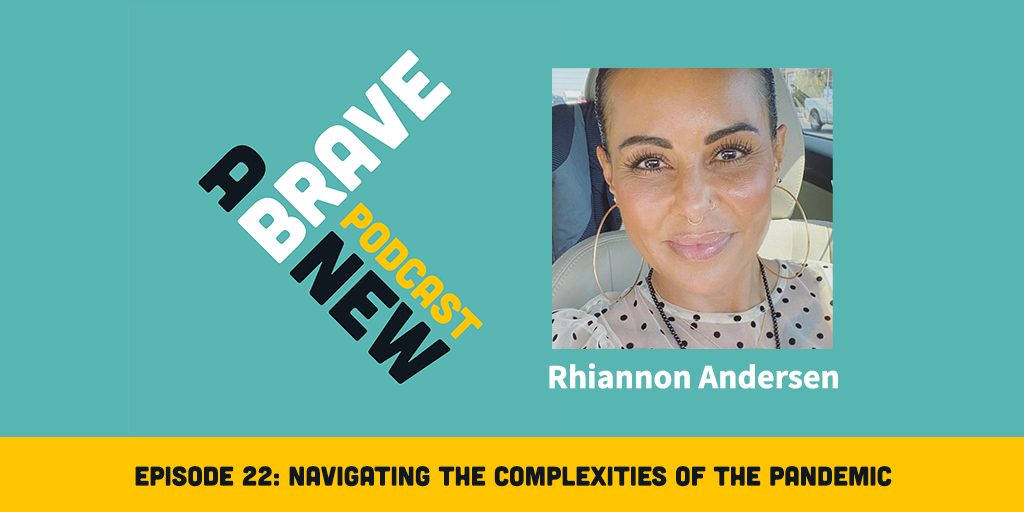Josh Dougherty is a brand strategist, speaker, and the founder and CEO of A Brave New, a Seattle-based B2B digital marketing agency specializing in tech and healthcare. Over the last decade plus, he’s worked with clients to develop unique brands and accelerate business growth using web design, inbound marketing, account-based marketing strategies.
What you’ll learn about in this episode:
- Why multiple viewpoints are essential in branding and strategy projects
- Why we fear giving (too many) stakeholders a voice
- How projects can be transformed by embracing stakeholder involvement
- Tools for:
- Building trust and engagement with stakeholders
- Facilitating health disagreement to create a better end product
- Incorporating stakeholder input without watering down the end product
- Working with other core team members to manage stakeholder involvement
- Maintaining momentum in your project
Additional resources:
Show Transcription:
Intro: Welcome to A Brave New Podcast, the podcast all about how big ideas, brave thinking and marketing smarts, help businesses grow. Here is your host, Josh Dougherty.
Josh: Hello, and welcome to A Brave New Podcast. My name is Josh Dougherty. I am your host and I am so excited to have you here today. Today, we're going to talk about something that I think is pretty important for many of the people that are managing marketing teams or managing user experience teams. And that's how do you successfully work with stakeholders on a large project? Maybe it's a branding project. Maybe it's a strategy development project. But regardless, the question is how do you work with these people successfully, especially when there's a lot of them? So as we get started, I wanted to bring you back to an experience I had many years ago. I was in a room with a number of people at a client, and we were on the brink of embarking on a major branding project. This was one of the country's premier cancer research centers, and they were doing really important work, right?
Researching new treatments to cancers, implementing those great treatments with the patients, doing amazing things, but they were at a crossroads as an organization. They just had their founder pass and they needed to figure out, "What is our identity going forward?" And everyone in that moment really understood and acknowledged that this was one of the most important projects that they could be doing because they needed to understand what does that brand identity look like? Now that we've lost this charismatic founder who really single handedly brought the organization into existence and helped to propel it forward for its first 20 years. So everyone knew the importance of this project, but they were scared to move forward. In fact, I remember many conversations with people, they felt nervous, they felt unsure of themselves. They felt unable to see whether everyone who would need to be involved in the project, if they could get to the outcome that they needed.
And why was there so much nerves? I think you probably sitting there understand why. I understand why there were numerous stakeholders. And I'm talking a ton, we had 20 people involved just in the working group, building out the brand. And then we had execs at both the institution itself. And a charitable foundation had to approve this brand that we would develop. We also needed the family of the founder to buy into the brand that we were developing. And we also had a community, right? That ultimately needed to buy in because the patients, the community, the donors, those people that are actually beneficiaries of the brand were the ones that really needed to buy in at the end of the day. And on top of that, everyone, every stakeholder within the organization, whether it be the audience that the patients, the community, or anyone in the working group or the execs on either the hospital research center side or the foundation side, all of them have these super important agendas and goals.
And I think we often think about agendas as being a negative thing, but here they weren't. They were important. They were trying to accomplish something that would push their mission forward. But the thing was, with so many people involved, and if we look at just the working group, each person had their agendas and goals, but they were often competing with each other. And so this caused a lot of nervousness because although someone maybe on the communication side wants to align everything really tightly, right? On the fundraising side, the fundraisers are looking for some freedom so that they're able to use best practice fundraising approaches. And this causes some concern and some stress, but this inevitable stress and concern was also driven by what they knew would be a complex approval process. When you have to essentially go up two organizations up into their executive teams and then to a family that's very influential in the organization, it can be hard to stare down at that approval process and say, "Is it worth it?"
So everyone knew the importance of this project, but they were nervous about whether that project could be done successfully. And the decision makers were scared of a few things like, are there going to be too many cooks in the kitchen? They also were fearful that if they involved everyone and fear is maybe too strong, I think maybe nervous or unsure of whether if they involved everyone, would the project ever get done, or would it be three years down the line, and you find yourself back where you started? Not really getting anything done, not really completing anything. There's also concerns, and I think many of us can echo this as we embark on major projects with lots of people engaged. There's concerns on whether the loudest person in the room will simply force their opinions to be the opinions that are adopted.
Are those quiet people going to also get a voice? Are they going to also be able to make an impact? And then finally, I think those who are going to have to push the project forward, the two directors that we were working with had to ask, "Professionally is this project in my best interests? If it's the set with the kind of potholes and those sorts of things that are all around." And those are real concerns. All these fears were super legitimate. And I think when someone is faced with these fears, they have a couple choices, right? They have a super important project. In this case, it was a branding project, but it may be some sort of strategy project, some sort of marketing strategy, project, something that's going to drive opinions and going to cause some disagreements, but is really important to your business, your organization, moving forward. When you're faced with this type of project, numerous stakeholders and fears, you can choose to do a couple things.
The first one is, you can choose to go it alone. Move forward in a small group, limit who has impact. And this is what a lot of people choose. But what I'd like to say to people who are considering this as I'm talking with them is this may seem easy at the time, but I am convinced that it causes way more work down the road as you have to do a consensus around very important things after you've unveiled your ideas. So there's the go alone strategy. You can also choose to really downplay the impact of the project. So the people of this cancer research center could have chosen rather than saying, "Let's unpack what the brand essence is, what our brand promises, what the changes to our visual identity need to be, what the emotions we want to evoke from our audience need to be." They could have chosen to scale it back and say, "What's a safer thing?
Okay, let's adjust some colors. Let's maybe change some rules about how we communicate, but we're not going to get to the core because we believe it's too hard to get to the core with all the stakeholders that we're going to have to work with." And this can lead to a successful project, but it can lead to a dramatically reduced impact. And so the question I'm often thinking about at this point is, is the impact worth the effort? I think for most of these strategic projects, the answer is yes. And so, as I'm sitting in the room with these people debating, my encouragement to them was, and my encouragement to you, if you are on the brink of a project like this, is to make the brave decision, move forward with open arms to your stakeholders, embrace that there's going to be a lot of people involved, embrace that it's going to be complex and like I said, that's a good thing.
Come at it with a little bit of positive regard, believing that each of these stakeholders is involved because they really care about your organization, your direction, and that their opinion is all about improving what you can do and what you can achieve. I know this can be scary, but I want to give you some tools in a little bit, so that it can be a little bit less scary. And I'm going to give you some tools. So you can really practice the skill of facilitation to make sure that we get an outcome that is going to be the absolute best outcome. One that works for everyone, but also the one that has the most impact. Because the key is we think about this brave decision of embracing stakeholders, bringing them into a process that's super vital to the organization, is that we have to make sure we avoid design by consensus, but we do build trust and inclusion throughout.
And so that's really what we did at this cancer center. The director of the foundation in the institute that we were talking with made the brave decision. They decided to push forward, to really dive in and try to pull apart the brand, understand those core things. And you know what? It took us some time, but we got to an outcome that everyone agreed on. And I think better, we got to an outcome that was the absolute best outcome for the organization. We designed a brand that really reflected who they were and who they had been, but allowed them to push and look forward to the future, to where they were going and what they could be that connected in with the things that their community and their audiences love the most about them, but also inspired people to think bigger. We built ownership throughout the process. With organizational leadership, with the community, with people on the ground who would be involved with actually implementing the brand.
And we launched a new brand. It took some time because I think at the end of the day, we had 20 people involved building the brand in close quarters, plus the folks at my agency and a partner agency we were working with. And we did all this while involving probably 40 people in the process, 50 people in the process over the whole course of the project. So I think the question here is how? How did that happen? How can we lead the process when we're going into a strategy or a branding project that allows us to gain this outcome? And that's really what I want to explore over the remainder of the podcast. And to do that, I'm going to share with you four tools that you can use in your next major strategy effort to work successfully with stakeholders, to manage that complex change that comes with any major project, whether it be a brand, whether it be a product redesign, whether it be setting the strategy direction.
And I'm going to give you the tools that can help you ultimately get your project over the finish line in better shape than if you would've excluded people. And I mean, it when I say in better shape. Not that you'll get it over the line and it'll be okay. But I think embracing the stakeholders, all the numerous stakeholders that you have to work with, truly embracing them, results in a stronger product, as long as you can manage the process with some skill and openness and good facilitation. So let's dive into what those tools are. I'll walk through them quickly here first, and then I'll dive into each one. But really the five things are this. One, involve stakeholders early and often to build trust. Two, encourage open conflict. Civil conflict, but open conflict. Three, decide what's precious and where you can give up ground. Four, utilize all the relationships that you have to build influence. And five, don't lose momentum. You need to build on each decision and drive through to the finish. So let's dive into the first one first. Involve stakeholders early and often to build trust.
And I think when we talk about involving people, I want you to be cognizant of the fact that I'm not asking you to invite someone in and become a decision maker on everything. What I'm saying is that, you need to involve them, empower people to have a voice, empower people to speak up, esteem them by making them feel heard, but be clear at the same time that you're going to make the decisions on the direction, and you're going to guide the process where you see fit. This allows you to establish them as a highly valued partner that you want to hear from, but not give up control of the entire process. And when you do this, it's super, super, super important that you mean it. Don't just say you want them to be involved and you want to hear from them, mean it. Get in there and listen, be inquisitive, be understanding, spend the time to see things from their perspective.
And when you do that, you're going to come away with a better product. So how do we do that? How do we involve people early and often to build trust? One of the best tools that I like to use for this is in-depth stakeholder interviews. These could be anywhere from 30 minutes to an hour with people. And when we're embarking say on a branding project, we like to go as broad as possible. Oftentimes, the conversation with a client is, "Hey, we only need to talk to the CEO, a couple of the C-suite, and maybe three other people." Let's just move forward after that. What I would say is I want to talk to as many people as you'll let me talk to in the organization. I want to see how they see the organization from their point of view. And then I especially insist that not only do I want to talk to those people who are sitting in positions of power, but I want to talk to the people who are the biggest attractors about the organization or about the process.
I want to talk to the people that are going to be the biggest influencers. Often those people aren't people with a title. And then I'm going to make all of them feel heard and appreciated by asking them real questions, by really internalizing their answers, by building trust and letting them know we're really trying to understand things. So interviews are a great tool. The other big tool I would talk about is inviting people in, stakeholders who are going to be involved throughout the process to give input on half finished work. This again is something that requires confidence, it's something that requires a bit of trust in yourself, but having done this numerous, numerous times, there's always this temptation to wait to get things 100% polished. Perfect, right? You want to get your little deliverable that you've been working on for so long to fit together perfectly to look perfect, to feel perfect.
But the problem with that is when you present something perfect to a stakeholder, they don't feel like they can provide input if they don't like it. Well, one, if they like it, they won't know how to build on it. They'll just say, "Okay, it's great." Which is okay. It's an okay outcome, right? But if they don't like it, they're just going to tear it down and say, "Toss it all out." Because they don't see any openness for input. So that's why I like to bring half finished work in, start showing it to people and getting input feedback and inviting people to positively help me improve it by saying, "What might we do to make this better? What might we do to look at this from another perspective? How might we build on it?" When we do this, you can maintain control of the project. You're also going to probably get some good nuggets that you actually want to implement.
And then you'll also have someone say, "Wow, I've never worked with someone on such an important project like our organization's brand, where they actually listen to me. And that part that got implemented right there, that's mine." That's powerful, right? If a stakeholder can say, "That part is mine, I am now bought into this because I can see myself in it." That's the first key to involving stakeholders. These interviews use half finished work input, to involve them early often build trust, real trust. The second tool that I encourage you to use in a project like this is encouraging open conflict. And I say civil open conflict because I'm not saying we want to be fighting with each other and getting really bad. But there's a way to form a productive conflict that really helps. And to illustrate this, there was a time many years ago when one of our agency partners called me and I picked up the phone and talked to her and she was pissed, fuming mad.
And I couldn't figure out what was going on. We had just had super successful meetings with one of our shared clients and for some reason or the other, she couldn't get over the fact that my co-founder Polly and I had openly disagreed in front of the client as we were working on a strategy. And now this is something that Polly and I did frequently on purpose, but she was so mad about it. Now this on-purpose disagreement was made to show that there's multiple ways to solve the problem. There's multiple ways to think about things. And this act had worked and we were able to build consensus with the client, but she just couldn't see it. Eventually we talked her off the ledge, but what we didn't tell her was that we usually encouraged and continue to encourage conflict as we struggle with big ideas and strategies.
And it's not just conflict between me and the other members of our team. It's openly inviting stakeholders who are in meetings to come into the conflict, to come into the challenge, to work together and to disagree and to try to disagree productively because civil conflict in meetings leads to a better idea almost every time. Because when people feel free to share their true opinions, not tearing down the other person, but saying, "You know what? I disagree. I think it's this direction we need to go. Let's flip it. Let's try a different way." Some light bulbs will go off. You'll have a breakthrough. And the truth is, if you don't encourage this type of honesty, this type of collaboration is what I would really call it, stakeholders bottle up what they really think anyways. And when they don't have a chance to say what they're thinking and they disagree, they're going to start to disengage or at worse, they'll start to actively undermine the entire process you're going through. The best way to keep the project moving in the right direction is really to get the conflict out in the open.
To encourage the battle of ideas, to pull out those that battle the best concepts, and then to use them to move the project forward. And that's what we would do in almost every conversation. Continue to do that in a workshop setting. And I really encourage you to lean into that as well. So after we're done involving stakeholders early and often, we're encouraging open civil conflict, productive conflict. I also encourage you to decide what's precious and where you can give up ground. Now, I'm a designer of words. I'm not a visual designer, but I get equally attached to the concepts that I come up with as a visual designer does. And early on in my career, there was always this tension of the client asking me to change what, to my campaign concept or asking me to adjust the brand in which way? What I came up with was brilliant. How dare the client suggest this? And that was just total immaturity. Because when we're designing something that's complex, we cannot be precious about every little part.
We need to protect the core important idea. That's what needs to be protected. There's a lot of gray area around it that can be changed and adjusted based on input from others. Even if we disagree with it sometimes, sometimes it's better to give someone a few feet of ground so that they can get behind the overall idea. So my encouragement to you in this is that you are going to run into a stakeholder who is going to force you to give ground, and you can either stick your foot in and fight for every inch and then have to give up ground and probably give up the ground that you do not want to give up, or you can choose ahead of time where you're willing to let someone else win. And then when the disagreement comes, you can give up what you were already prepared to give up. You can make someone feel heard and give them a meaningful chance to change things, and you can still move the project forward without losing any of the core pieces.
The you as the one who's facilitating the process has come up with and has made. Then when you're going through this process, I think it's important to note always upfront what you're willing to give, where you're willing to accept the input, before you say what you won't yield on. Start with yes, then move to no and explain why it's a no, and then smile and be friendly. People like to agree with someone who's friendly. They would rather disagree with someone who's friendly too. And then I think if you're going to take this concept further of deciding what's precious, and then what isn't as precious, I think you can choose again when you're developing out a brand where you can grant ownership in the process where you can bring in your biggest critics and give them ownership over a piece of the branding process so that they can feel like they have a say. Bring them into the fold like Lincoln did with this team of rivals, then lean in and work with them.
I think you'll find that your biggest critics are some of the smartest people, and that you can really leverage them and they can become valuable, valuable partners in building a great brand, building a great strategy or many other things. And that brings me to my final point. So you're deciding where you can give up ground and where you're going. What is really precious. You're involving stakeholders early and often, and you are encouraging open civil conflict. Now you've gotten a long way. You maybe are even getting to the point where you have some concepts coming together. Things start to be gelling. And now it's time to remember to utilize all of the relationships that you have, because the truth is that you can exert as much influence as you want, but you won't be able to get it done alone. And that's really what we've been talking about today, exerting influence, but you won't be able to do it alone, especially in a project where you have 20, 30 people involved.
You need to have key supporters in your organization who you can rely on to influence people that you don't have sway over. And then you need to make sure you're arming them. Being their best supporter and encouraging those people who are going to influence on your behalf or influence, we should say, on the project's behalf, encourage them to be brave. At the cancer center, we had a director of the foundation who had a close relationship with the family of the founder. And she served as the lead on the project with that family. She walked alongside them. She brought them alongside in the thinking. She urged them to have a fresh perspective on it. And what happened was that she was able to bring the children of that founder along with the process. We also had a director of communications at the institute itself who was frequently checking in with the CEO, building consensus, making sure there was trust throughout the process.
And then when we brought the CEO in to review what we had come up with and what we had built together, she was already pretty bought into the process. And the reality is I could have done all of the things that I spoke of ahead or before this well, but without these two people influencing the process, we would've failed. Sometimes it's important to realize that you are not the be all end all of influence. You need partners who are going to push forward with you. And the final thing, like I'd mentioned, just a little bonus is don't lose momentum when you're in a project like this, when you're working with numerous stakeholders. Don't stop. There's a temptation to move slowly. And then when you get through a milestone to stop. Keep pushing, keep moving. When there's so many people involved, when you stop getting going forward again is nearly impossible.
And as you move through each step, I think remind people where they've come from, what they've accomplished and where we're going, and then keep pushing. Don't get caught up on barriers. Barriers aren't an excuse to stop. They're an excuse to think differently about how to solve something. If you can do this, you're going to build on success. So the next time you're about to embark on a project that's complex like a brand, a multi-year marketing strategy, a customer acquisition strategy. And if you're staring at the gauntlet of stakeholders, I want to encourage you to be brave. I want to encourage you to have an abundance mentality, a mentality that the more input the better. I want you to show people positive regard and step into the challenge, utilize the tools we've talked about today and create something great with the help of numerous people. You don't have to fall victim to consensus thinking.
You don't have to do it alone. You don't have to scale back the impact of your project. I'd encourage you to embrace the idea of involving the stakeholders early and often. Building trust, encouraging open and civil conflict, decide what's precious and where you can give up ground. Utilize all the relationships that you have and focus on not losing momentum. And push that project through to have its maximum impact. At the end of the day, you're going to be able to step back and say, "Look what I accomplished with the help of all my stakeholders, and look how much better our organization is for it." Thanks so much for joining me today. I hope you have a great rest of your day, wherever you're off to next. And can't wait to see you back for the next episode. Have a good one. See you.
Outro: Thanks for listening to this episode of A Brave New Podcast. Go to abravenew.com for more resources and advice. If you enjoyed this episode, show us some love by subscribing, reading and reviewing A Brave New Podcast wherever you listen to your podcasts.
Similar Articles
OCT 11, 2021

The Beginner’s Guide to Generating Inbound Leads
Marketing doesn’t have to be painfully intrusive, like getting yet another telemarketing call right when you sit down to dinner with your family.
OCT 11, 2021

The Beginner’s Guide to Generating Inbound Leads
Marketing doesn’t have to be painfully intrusive, like getting yet another telemarketing call right when you sit down to dinner with your family.


